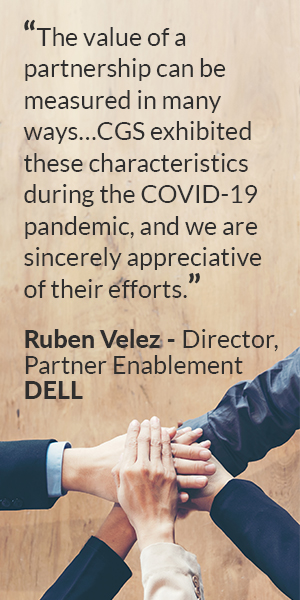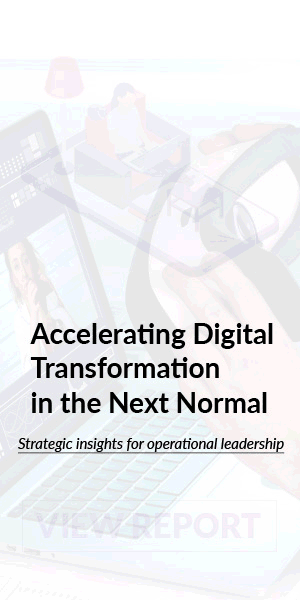Using Augmented Reality to Digitally Transform Frontline Support in the Post-COVID Era

While there are promising signs of an end to the COVID-19 pandemic, the scale of business implications show no signs of waning as we turn the corner into 2021. Consequently, enterprises must continue to pivot and embrace remote or hybrid work for frontline support services for an indefinite period.
Toshiba Global Commerce Solutions (TGCS) has pursued a proactive strategy to address the ongoing need for high-quality remote field support during the COVID-19 crisis. TGCS, a subsidiary of Toshiba TEC Corporation, offers comprehensive point-of-sale solutions to diverse retailers, mass merchandisers, and hospitality firms worldwide. In a recent panel discussion, TCGS’s Client Services Delivery team—represented by Chris Lemley (executive director of managed services) and Brian Osborne (client delivery executive)—discussed how they’re delivering hands-on maintenance, repair, training, and other support functions to and through remote personnel during the ongoing pandemic.
TGCS called out the pivotal importance of CGS’ augmented reality (AR) solution—Teamwork AR--to support field service productivity and operational resilience during this challenging period. Prior to the COVID-19 crisis, Toshiba had already implemented CGS’ outsourced AR offerings for remote learning. Since the onset of the crisis, Toshiba’s use of AR in field service has increased significantly as it, like many organizations, has had to provide more frontline operations, repair, maintenance, and training services remotely. It has relied on AR to provide remote field technicians, working from their homes or remote offices, with hands-on experience with essential equipment.
In the panel discussion, TCGS discussed several key outcomes that they’ve achieved from deployment of AR into their post-COVID remote service environment: Canva? Dan have ideas?
- Learning at the time of need for remote service technicians: Using AR, TGCS field service technicians now have real time access to experiential training materials through remote access to a central repository. They can more easily access new courses and update tech notes on the fly. This allows them to stay current on different technologies across diverse product platforms. Field personnel are also experiencing improvements in product repair processes and greater retention of technical knowledge, while the business is realizing reductions in training delivery costs and enhancements in customer experience.
- Comprehensive visibility into remote service technicians’ performance: Using AR, TGCS field service technicians have more comprehensive visibility across diverse key performance indicators and service metrics. This visibility enables TGCS to determine which team members have lower first-time fix rates across certain product lines. It allows the company to see how often each technician is accessing training for a specific product. It also enables supervisors to work directly with individual technicians to understand where specifically they're facing challenges, which supports curation of additional training to meet those needs.
- Consistent delivery of company-wide training to remote service technicians: Using AR, TGCS enables a more consistent delivery of training across distributed field services personnel. Previously, the company would have to fly technicians to training facilities, an approach that entails greater expenses and overhead. Now, these same technicians can access the latest training updates remotely from wherever they are, including while live at a customer facility.
TGCS’ Osborne specifically called out several advantages from deploying CGS Teamwork AR for their remote service environments:
- Ensure that the AR rollout is adaptable to your enterprise mobile infrastructure: “Our pilot was on iPhone devices, but our rollout was on Android devices….Teamwork AR [best] fit our business needs because we could adapt it into our existing infrastructure without adding additional [mobile] technology to our technicians. ….[The solution] is very flexible in that it allows you to host this solution on a multitude of different platforms. And if you already have mobile devices and solutions already deployed, there's no need to add in additional products, hardware, to be able to facilitate the solution. So it doesn't mean that you can't continually kind of enhance it over time. But the barrier to entry into the solution is very cost effective.”
- Provide agility for the AR to operate in intermittently connected environments: “Our customers are national. So whether it be in Montana or New York City, we still have customers that we're supporting, and we need access to, and we may not have cell phone coverage [in some locations] for data service available to download the application or support, or to view the content or do that data feed….It's been a great solution in its ability to download the contents remotely, when that when our technicians are within on a Wi Fi or within range. And then they can operate in an offline mode, and have access to all the all the content that we put together, whether it be the digital instruction, whether it be the live video content, or whether it be the augmented reality interactions.”
- Assess the AR-gathered remote service metrics in your enterprise reporting environment: “What I found valuable was the level of detail we can get into the end of the reporting, and tie it out to the modules that we create. So for each module, or each course segment, shall we say, we can get it down to how often our technicians interact or use the interact, function, measure and report out on the augmented reality use, and then it's a robust report that we get and that we can tie into with our Tableau solution. And when we then take that and then tie it to our field performance, so how long it takes our repair actions to be performed, and we can look even further as to what's being done. And if we have a component that's a little bit taking more time to repair. How often is that individual student accessing the available education or the develop available augmented reality interactions and then it Is there an opportunity to either enhance or provide additional instruction?”
To learn more about how TCGS is working with CGS to digitally transform its field-service operations for the post-COVID future, check out the video of the full panel discussion.
To learn more about how CGS Teamwork AR can help your organization to deliver remote guidance and interactive support, check out this online resource.
And to delve more deeply into TGCS’ case study using Teamwork AR for remote support, check out this online resource.


